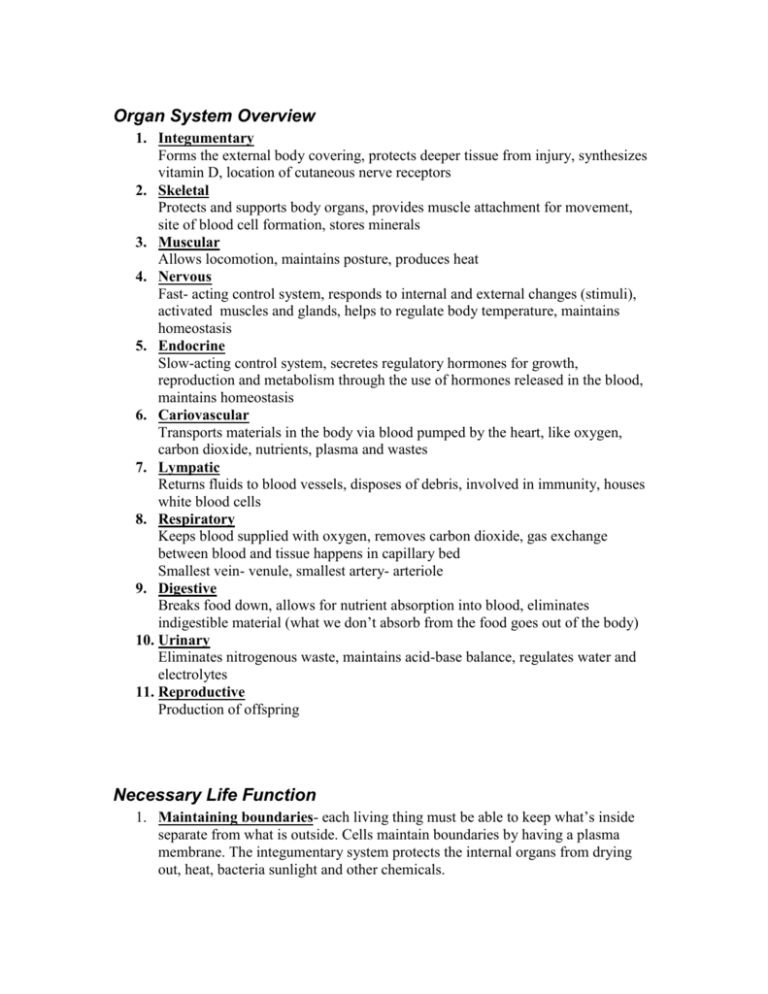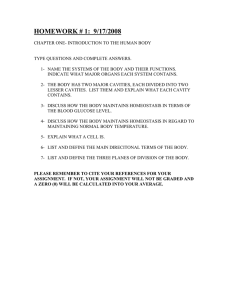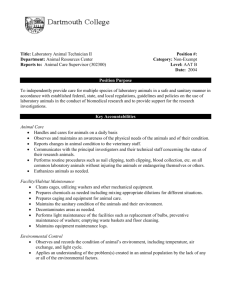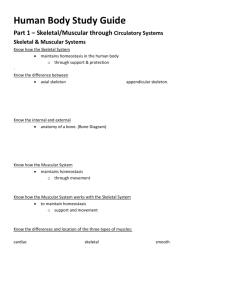Organ System Overview
advertisement

Organ System Overview 1. Integumentary Forms the external body covering, protects deeper tissue from injury, synthesizes vitamin D, location of cutaneous nerve receptors 2. Skeletal Protects and supports body organs, provides muscle attachment for movement, site of blood cell formation, stores minerals 3. Muscular Allows locomotion, maintains posture, produces heat 4. Nervous Fast- acting control system, responds to internal and external changes (stimuli), activated muscles and glands, helps to regulate body temperature, maintains homeostasis 5. Endocrine Slow-acting control system, secretes regulatory hormones for growth, reproduction and metabolism through the use of hormones released in the blood, maintains homeostasis 6. Cariovascular Transports materials in the body via blood pumped by the heart, like oxygen, carbon dioxide, nutrients, plasma and wastes 7. Lympatic Returns fluids to blood vessels, disposes of debris, involved in immunity, houses white blood cells 8. Respiratory Keeps blood supplied with oxygen, removes carbon dioxide, gas exchange between blood and tissue happens in capillary bed Smallest vein- venule, smallest artery- arteriole 9. Digestive Breaks food down, allows for nutrient absorption into blood, eliminates indigestible material (what we don’t absorb from the food goes out of the body) 10. Urinary Eliminates nitrogenous waste, maintains acid-base balance, regulates water and electrolytes 11. Reproductive Production of offspring Necessary Life Function 1. Maintaining boundaries- each living thing must be able to keep what’s inside separate from what is outside. Cells maintain boundaries by having a plasma membrane. The integumentary system protects the internal organs from drying out, heat, bacteria sunlight and other chemicals. 2. Movement- locomotion, movement of substances (nutrients- by blood vessels, wastes by dietary tract) 3. Responsiveness- ability to sense changes and react (nervous system) 4. Digestion- break down and delivery of nutrients 5. Metabolism- refers to all the chemical reactions in the body, breaking down substances and building substances (synthesizing) production of energy, making body structures 6. Excretion- elimination of waste from metabolic reactions 7. Reproduction- production of future generation 8. Growth- increasing of cell size and more often growth is by increasing the number of cells. For growth to occur, cell construction must occur faster than cell destruction. Survival Needs 1. Nutrients- chemicals for energy and cell building. Includes carbohydrates, proteins, lipids, vitamins and minerals. 2. Oxygen- required for chemical reactions. Most of energy produced in the body uses oxygen. **MOST IMPORTANT SURVIVAL NEED** 3. Water- 60-80% of body weight, most abundant chemical substance in body. Provides the fluid base for body secretions and excretions. Provides for metabolic reaction. 4. Stable body temperature- chemical reactions are affected (refers to metabolism) 5. Atmospheric pressure- must be stable. This is the force exerted on the surface of the body by the weight of the air. The function of breathing depends upon the appropriate atmospheric pressure. **HOMEOSTASIS** Describes the body’s ability to maintain a relatively stable internal environment even though the world outside the body is changing. We have to maintain a dynamic state of equilibrium inside the body. We have 2 systems that help in maintaining homeostasisNervous and Endocrine









